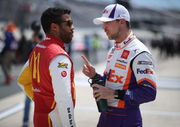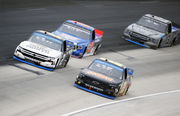
USA Today via Reuters
Jul 15, 2023; Loudon, New Hampshire, USA; NASCAR Xfinity Series driver John Hunter Nemechek (20) takes the lead during the Ambetter 200 at New Hampshire Motor Speedway. Mandatory Credit: Eric Canha-USA TODAY Sports

USA Today via Reuters
Jul 15, 2023; Loudon, New Hampshire, USA; NASCAR Xfinity Series driver John Hunter Nemechek (20) takes the lead during the Ambetter 200 at New Hampshire Motor Speedway. Mandatory Credit: Eric Canha-USA TODAY Sports
There’s a dish online about a recent image suggesting a couple of exciting developments for the Xfinity Series. First off, it looks like Xfinity is making a comeback to the Brickyard and Michigan. But the thing is, both speedways are set to feature superspeedway engines. That’s right, the Xfinity series is thinking of rolling out a combo of superspeedway engines and intermediate aero packages in Indianapolis and Michigan.
This wouldn’t be NASCAR’s first rodeo trying to spice things up with superspeedway packages on intermediate tracks. They’re aiming for a mix of thrills and safety. Remember back in 2017? They gave this a shot, but it didn’t quite hit the mark then. It looks like they’re gearing up for another go-around, testing the waters to see if they can strike the right balance this time. Let’s wait and see how this pans out.
ADVERTISEMENT
Article continues below this ad
The story behind NASCAR’s Superspeedway Package
The superspeedway engine package, mainly used at speed giants like Daytona and Talladega, is all about reining in those breakneck speeds. It’s a nod to safety, using devices like restrictor plates and tapered spacers to cut back on horsepower. This whole idea took off after a heart-stopping moment in 1987 at Talladega, where Bobby Allison’s car nearly took flight into the grandstands.
Since then, NASCAR’s been all about putting the brakes on speed in its National Touring Series. Initially meant to boost safety, these restrictor plates ended up creating tightly packed races, with cars zooming at similar speeds. Whether it made racing more thrilling or riskier is up for debate. But it sure got NASCAR thinking: what if they brought this vibe to other tracks?
Take Atlanta Motor Speedway, for instance; it’s been racing like a superspeedway these last two seasons. Now, NASCAR’s got its sights set on replicating this at the Brickyard and, notably, Michigan. But this isn’t the first rodeo for the Xfinity Series with restrictor plates at these tracks, though.
Back in 2017, NASCAR was on a mission to spice up the races at Indianapolis Motor Speedway, hoping for excitement minus the chaos. They experimented with Xfinity Series engines, aiming to make the cars drafty and slingshot-like trucks. NASCAR slapped a restrictor plate on the Xfinity cars to dial down the horsepower, tweaked the rear spoiler, and added air ducts to mimic the airflow of a truck.
While drivers like Kyle Busch and Brad Keselowski weren’t exactly fans of the idea, NASCAR noticed a record number of lead changes during that race and kept the wheels turning on this concept. Now, they’re planning to apply a similar strategy, focusing on reducing horsepower with restrictor plates. The approach is already in play at Atlanta; will it bring pack-style racing to Michigan?
NASCAR is aiming for closer racing across the board, blurring the lines between road courses and other ovals. But should they? Each track and each car have their flavor of racing. Road courses are about strategy, and superspeedways are about speed and excitement. Muddling these styles might not be the best move. Like, do we want to transform the unique character of Indianapolis into a mini-Daytona? Or turn Michigan into a superspeedway lookalike?
Watch This Story: NASCAR Legend Tony Stewart’s New Challenge: Swapping Race Tracks for Diaper Duty!
Besides that, another reason to stop such experiments would be that fans weren’t exactly over the moon with the original superspeedway package in 2017. Maybe, just maybe, NASCAR could take a page from that book and rethink this one.
ADVERTISEMENT
Article continues below this ad
Trending
Unpacking the dislike for the original Superspeedway Package
So, why did the original superspeedway package rub fans and some drivers the wrong way? Back when it was first rolled out in Indianapolis, the idea was to dodge wrecks and keep the cars bunched up on the track. Sure, it did lead to a nail-biting finish with William Byron just edging out Paul Menard, and NASCAR seemed pretty chuffed with the outcome. They even brought this package to Michigan and Pocono the following year. Eventually, a similar vibe was adopted in the Cup Series for all intermediate tracks from 2019 to 2021 with the 550 horsepower package.
But even with tighter finishes and more lead changes, why did it get the thumbs down from many in the NASCAR community? Well, the package wasn’t without its pitfalls. For starters, the combo of more downforce and less power made the cars less twitchy and, frankly, easier to drive. The high drag created more ‘dirty air’ behind the lead car, turning following and overtaking into a real headache. Sure, the races were closer, but many argued that the actual racing lost a bit of its edge.
ADVERTISEMENT
Article continues below this ad
Love it or hate it, this package is making a comeback in 2024. But will it hit the mark this time around?
ADVERTISEMENT
ADVERTISEMENT
ADVERTISEMENT
ADVERTISEMENT






